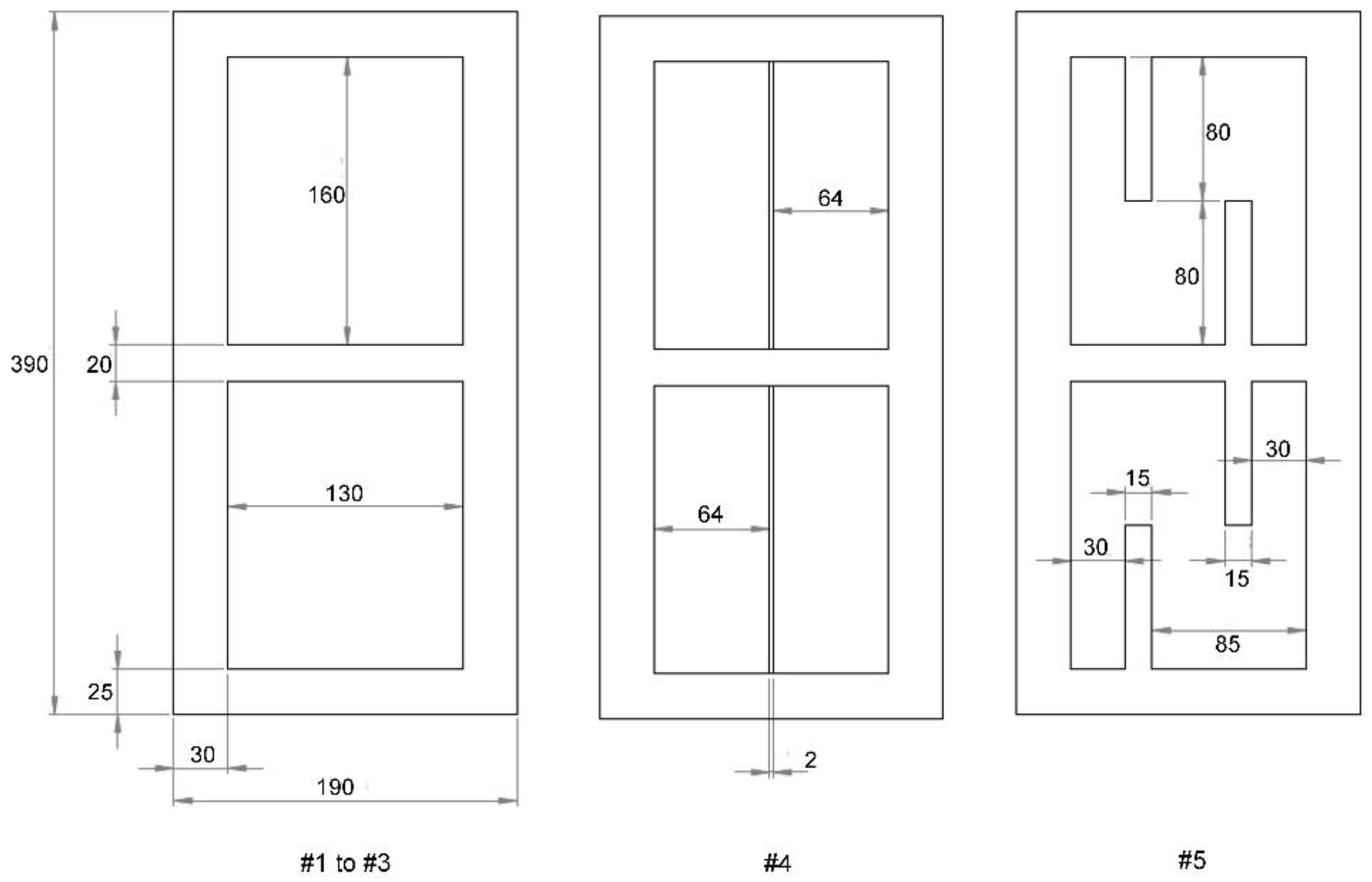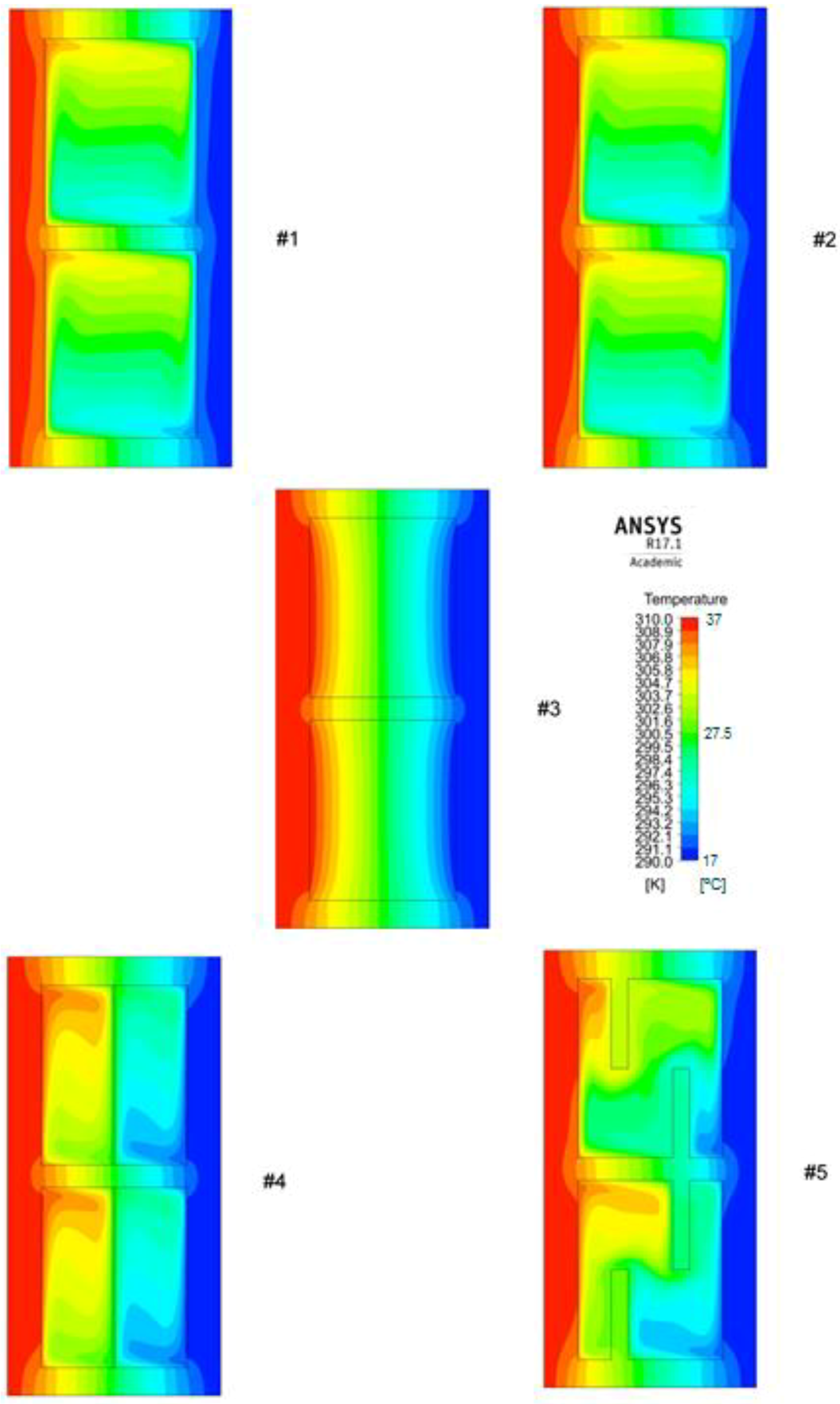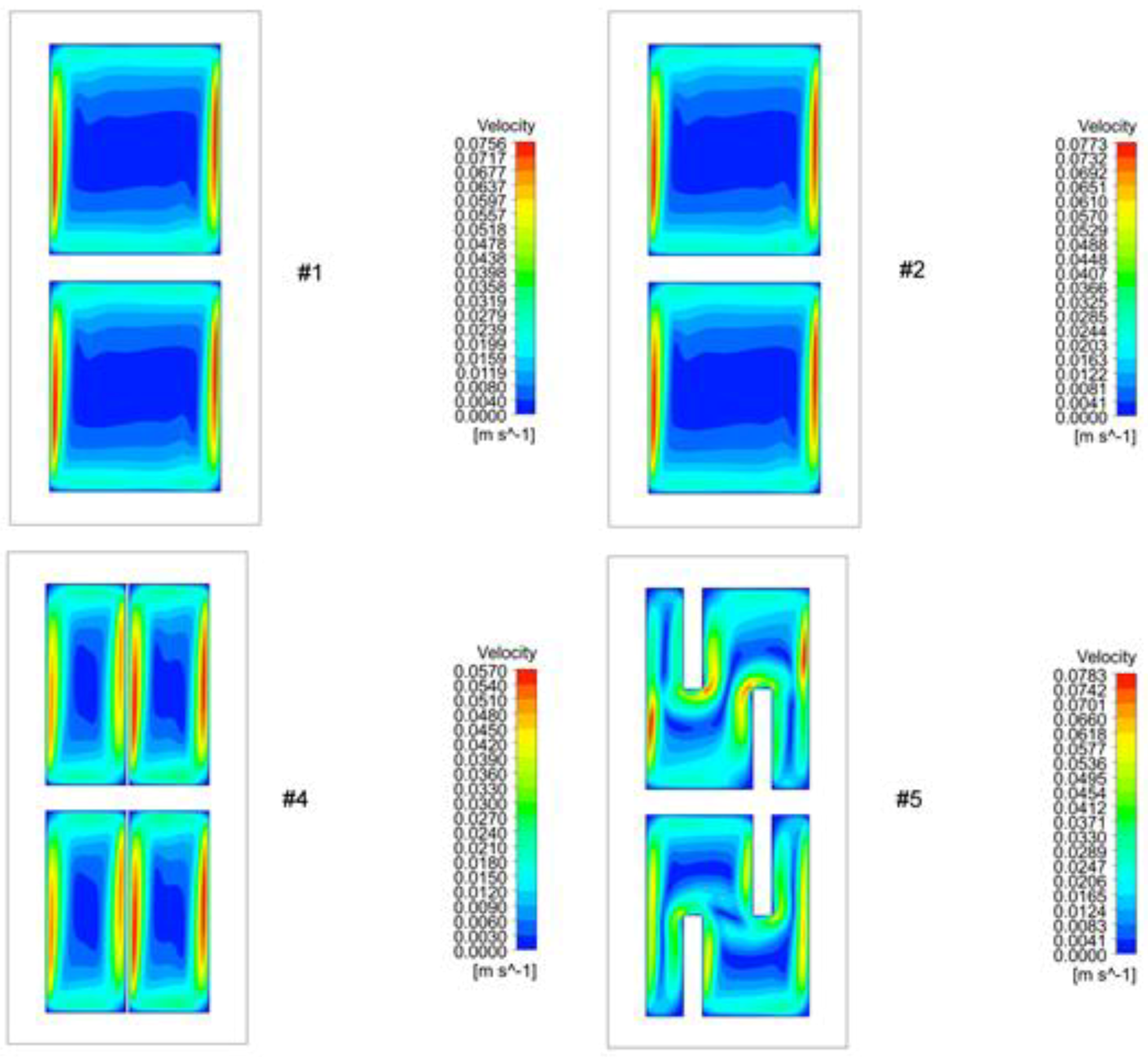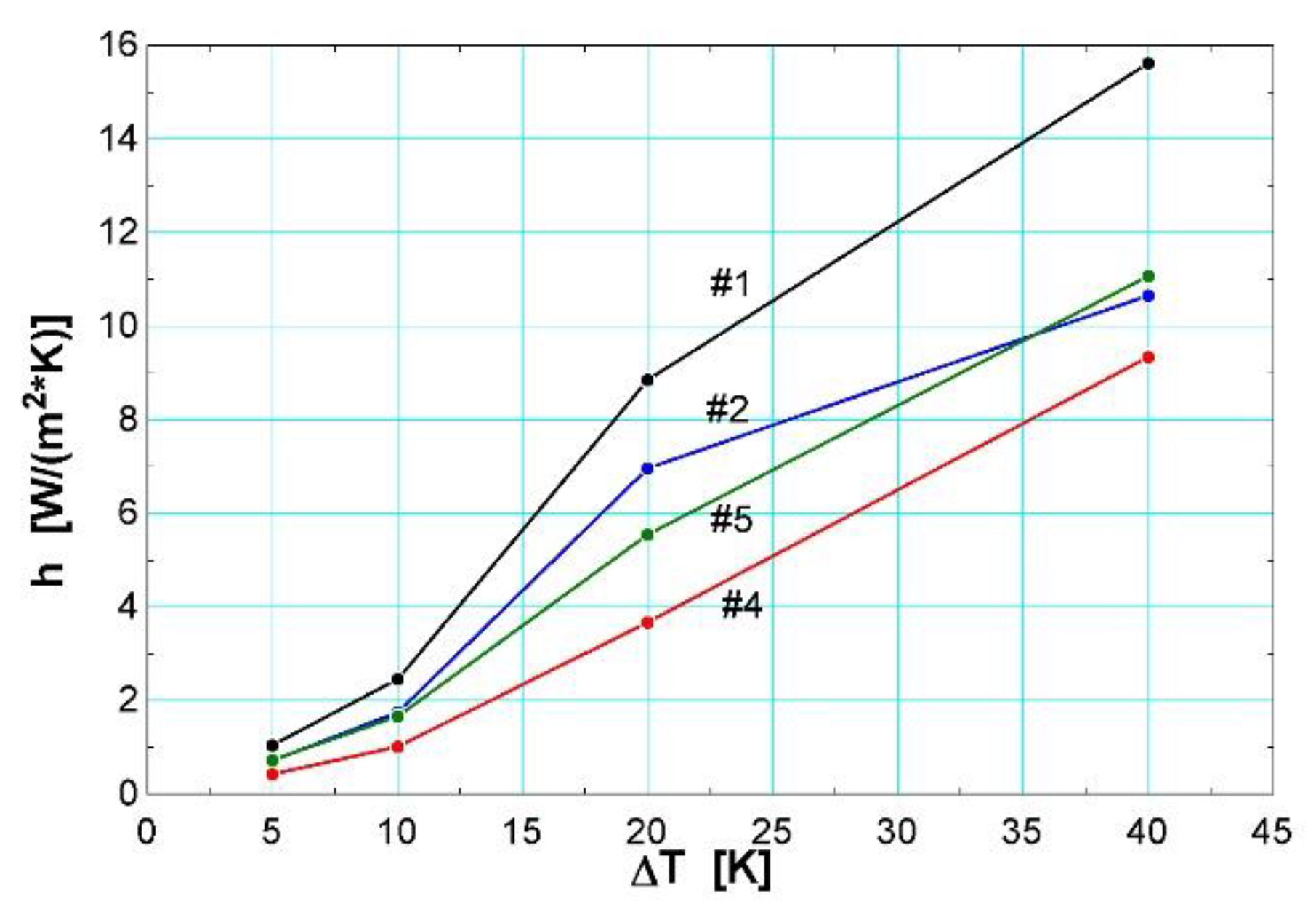1. Introduction
Building energy consumption usually takes a significant percentage of the total energy consumption. According to BEN 2018 (The Brazilian Energy Balance) [
1], energy consumption in residential, commercial, and public sectors represents 15.4% of the final consumption in Brazil. In the United States, heating, ventilation, and air conditioning (HVAC) systems for buildings comprise about 50% of the building energy consumption and 20% of total consumption.
In this context, the heat transfer through the building envelope is one factor that influences the HVAC energy consumption in a crucial way. Choosing the proper material for wall construction is a vital parameter for contributing to the sustainability of construction sectors and providing thermal comfort for the inhabitants [
2,
3,
4,
5]. The overall performance of the building envelope depends on many factors, such as the thermophysical properties of all materials used in the wall, thickness and material assembly, the adoption of air-gap and its ventilation level, among others. This work focuses on a specific component. In developing countries, hollow concrete blocks have become common in recent years due to advantages such as strength, fast construction, space for pipes and wiring, and the small amount of waste produced during the construction process.
Several studies have been conducted to understand the phenomenon of heat transfer in hollow blocks. In an interesting study, Cianfrini et al. [
6] investigated the impact of insulation filling in hollow blocks and the role played by filling in thermal inertia of walls, and the results showed that for some blocks, a lower front mass can lead to a higher time lag, which is found to describe building performance in the literature. Caruana et al. [
7] used 10 different techniques and parameters for measuring the thermal performance of the hollow blocks, describing the differences between them and comparing them with the standard.
Santos and Mendes [
8] elaborated a numerical study on heat, air, and moisture transfer through hollow blocks using a model based on three driving potentials described in detail in [
9]. They concluded that when the coupled heat, air, and moisture transfer is taken into account, the values of transmittance differ from those obtained by assuming pure conductive heat transfer.
In another analysis, Antar and Baig [
10] suggested a new layout in hollow blocks with three cavities for increasing the thermal resistance and used a numerical method to calculate the thermal transmittance. In other work, in order to improve the design of the hollow block, Zhang and Wang [
11] presented a simple numerical approach of the heat transfer through a wall with hollow blocks and found that by reducing the rib width and hole number in each row, the thermal performance could be improved. They also recommended an increase in the number of rows of holes rather than hole thickness of a hollow block. It was observed that increasing the block thickness with an increase in hole spacing was more effective than increasing the hole rate. Xamán et al. [
12] also performed a numerical study on hollow blocks with and without insulating and reflective materials for roofing. The results showed that a change in the configuration of insulating could improve the thermal insulation by 46.3%.
According to the works found in the literature, several studies are presented with the purpose of reducing the thermal transmittance and consequently increasing the thermal performance of the hollow blocks. However, studies comparing various types of insulation are still barely explored. Thus, effects of the low emissivity, insulating material, radiant shields, and baffles on the inner cavities of the blocks are presented in this paper. Effects of temperature differences between the exterior surfaces on the thermal transmittance and the combined average heat transfer coefficient inside the cavities are also shown.
2. Materials and Methods
The thermal transmittance of concrete building blocks was obtained by performing computational fluid dynamics (CFD) simulations, considering two-dimensional steady-state analysis for five different block configurations. These simulations were performed on the software ANSYS Workbench 17.1 using the CFD package ANSYS Fluent 17.1. In this section, the physical domain of the studied blocks, boundary conditions, simulation procedure, thermophysical properties, and mesh validation is presented.
2.1. Physical Domain
For all five configurations, the concrete blocks were considered to have the same external dimensions, which were 190-mm length and 390-mm height, the same as the ones provided by the Brazilian regulation [
13] for a standard concrete block. Block #1 was considered as the standard configuration without any form of insulation applied to reduce the thermal transmittance. Block #2 was considered the low emissivity on the inner surfaces, block #3 had its cavities filled with insulating material, block #4 had radiant shields in the middle of its cavities, and block #5 was conceived with baffles in the inner surfaces. The dimensions of blocks #1 through #5 are shown in
Figure 1.
2.2. Boundary Conditions
Dirichlet and Neumann-type boundary conditions were considered in this study. Two parallel external surfaces were conceived as isothermal, which made it possible for a heat transfer process to occur through the block. The other boundaries were considered as insulated surfaces. These boundary conditions are visualized in
Figure 2, where TA and TB are the different constant temperature values. The average temperature value was always 300 K.
2.3. Simulation Procedure
The simulations were performed considering a steady-state condition and laminar flow for the cases where the cavities were filled with air. The thermal radiation inside the cavities was simulated by the discrete ordinates radiation model [
14].
As mentioned, five kinds of blocks were considered, each with different methods to reduce the heat transfer intensity. The method used for each block is shown in
Table 1. In order to evaluate the effects of temperature differences between external surfaces on the heat transfer, the thermal transmittance was calculated using temperature differences of 5 K, 10 K, 20 K, and 40 K.
2.4. Thermophysical Properties
An accurate simulation of air behavior inside the cavities was important in order to obtain credible results. This accuracy depended in part on appropriate air properties informed by the CFD program. The air density, which is an extremely important property for simulating the buoyancy process, was established by the equation of state for real gases developed by Peng and Robinson [
15]. The other air properties necessary to simulate the process were obtained from thermodynamic tables [
16]. These properties are shown in
Table 2.
The thermal properties of the solid materials were considered as constant values and obtained from thermodynamic tables [
16]. These property values are shown in
Table 3. In case #2, the low emissivity coating was considered to be the same used by Principi and Fioretti [
17] with an emissivity value of ε = 0.5.
2.5. Mesh Verification
For this study, we conceived a structured mesh with quadrilateral elements. In the solid region, these elements had a 1 mm size, and in the fluid regions, a 0.5 mm size. In numerical simulations, convergence problems and mesh dependence are higher in the air domain than in the solid region. Accordingly, the verification of this mesh was performed by temperature profiles comparison between the considered mesh and a benchmark solution provided by Wakashima and Saitoh [
18]. In this benchmark, it was considered a free convection situation in a square cavity with two vertical isothermal surfaces and two horizontal insulated surfaces restraining a flow of Rayleigh number Ra = 1 × 10
6. The profiles of the validation test and the benchmark solution are visualized in
Figure 3.
It can be seen that the mesh chosen for this study was in agreement with the benchmark solution. In the center of the cavity, by varying the position on the y axis, the maximum difference was 5% in the temperature dimensionless values. In this case, this mesh was applied to this work because, apart from the acceptability of temperature profiles, the boundary conditions used in this study were similar to those of the benchmark solution.
3. Results and Discussion
This section analyzes the effects of different measures applied to reduce the thermal transmittance and the influence of the temperature differences on the transmittance in the case of hollow blocks.
3.1. Effect of the Measures Applied to Reduce Transmittance
In the first step, we evaluated the results of thermal transmittance obtained for all the blocks, considering a 20-K temperature difference between the external surfaces. The temperature profiles of blocks #1 through #5 for this boundary condition are shown in
Figure 4.
The values obtained through the heat transfer simulation for the thermal transmittance (U) and the combined average heat transfer coefficient inside the cavities (h), as well as the reduction in transmittance related to block #1, are shown in
Table 4.
The transmittance value calculated for block #1, 6.07 W/(m²·K), was not far from the value of 5.50 W/(m²·K) obtained for this block by using the calculation procedure available in international regulation standards [
19].
An improvement on the performance of the standard block was observed with the application of the low emissivity coating in the cavities surfaces in case #2, reducing the cavity heat transfer coefficient and consequently reducing the thermal transmittance. In this case, the thermal transmittance of the hollow block was reduced by 19.1%. For determined multi-holed block geometry with same coating considered, Principi and Fioretti [
17] observed a reduction of 19.4%.
The most remarkable result in terms of low heat transfer was obtained from block #3, which achieved a 68.9% reduction in thermal transmittance when compared to block #1. The polystyrene filling of the cavities disabled the effects of free convection and thermal radiation inside of them. These factors added to the low thermal conductivity of polystyrene, allowing the significant reduction. In an experimental study, Pavlik et al. [
20] observed a reduction of 32% in transmittance when filling a hollow block with polystyrene balls. The decrease in transmittance calculated in this study was higher than the experimental value because the original geometry conceived by Pavlik et al. [
20] did not provide good conditions for convection and radiation.
The second best thermal performance was obtained in the case of block #4, which had the aluminum foils placed in the center of cavities acting as radiant shields. This case presented a 44.3% reduction in thermal transmittance and the lowest value of the combined heat transfer coefficient [3.68 W/(m²·K)]. This low value reached was due to two factors—the aluminum foil decreased the radiation heat transfer, and the shield acted as a confinement barrier, not allowing the air circulation in high velocities, as observed in
Figure 5. These velocity profiles of the air inside the hollow blocks were responsible for the temperature gradients observed in
Figure 4.
At last, considering the baffles in the cavities surfaces in case #5, the reduction calculated in thermal transmittance was 22.2% when compared to block #1. These results were very similar to the ones obtained for block #2. In a similar situation, Alhazmy [
21] also observed some reduction in the heat transfer coefficient inside the cavities with the presence of two vertical baffles per cavity (the same method conceived in this study).
3.2. Effect of Temperature Difference on Thermal Transmittance
The calculated values of thermal transmittance for each hollow block under distinct temperature differences are shown in
Table 5.
In all cases, an increase in thermal transmittance due to the increase in temperature difference was observed. In part, this was due to a gain in the free convection effect in the cavity, which was illustrated by the increase in air velocity and is shown in
Figure 6.
Besides air velocity, radiation heat transfer also increased with larger temperature differences. In
Figure 7, it can be seen that the difference in temperature effects is noticed on the value calculated for the combined average heat transfer coefficient. It should be noted that among all the hollow blocks, aluminum foil shield (#4) was the one that presented the lowest values under all circumstances. When a larger temperature difference was used (above 37 K) between the surfaces and when the effects of thermal radiation were more important, the low emissivity coating (#2) presented a greater potential for the reduction of the heat flow than the concrete baffles (#5), where the convective effect was predominant.
4. Conclusions
A numerical two-dimensional steady-state analysis of the effects of some means to decrease thermal transmittance in hollow concrete blocks was performed. Although many factors influence the overall performance of the building envelope—the mortar joints, for example—this work focused on the thermal performance of concrete hollow blocks. Considering 20-K of temperature differences between the external surfaces, an improvement of 19.1% in the performance of the standard block was observed with the application of the low emissivity coating in the cavities surfaces.
The most remarkable result in terms of low heat transfer was obtained with the polystyrene filling of the cavities, which disabled the effects of free convection and thermal radiation inside of them. The second best thermal performance was obtained with aluminum foils placed in the center of cavities, which acted as radiant shields. This case presented a 44.3% reduction in the thermal transmittance. At last, when we utilized baffles in the cavities surfaces, the reduction calculated was of 22.2%.
When the effects of temperature differences were verified, an increase in thermal transmittance was observed due to the gain in the free convection and radiation heat transfer.
Considering environmental issues and the results presented in this work, the radiant shields (produced from recyclable material) can be considered an interesting method to obtaining low thermal transmittance in hollow blocks.
For further work, numerical simulations will compare with experimental tests considering the moisture effects on the thermal performance of hollow blocks.











